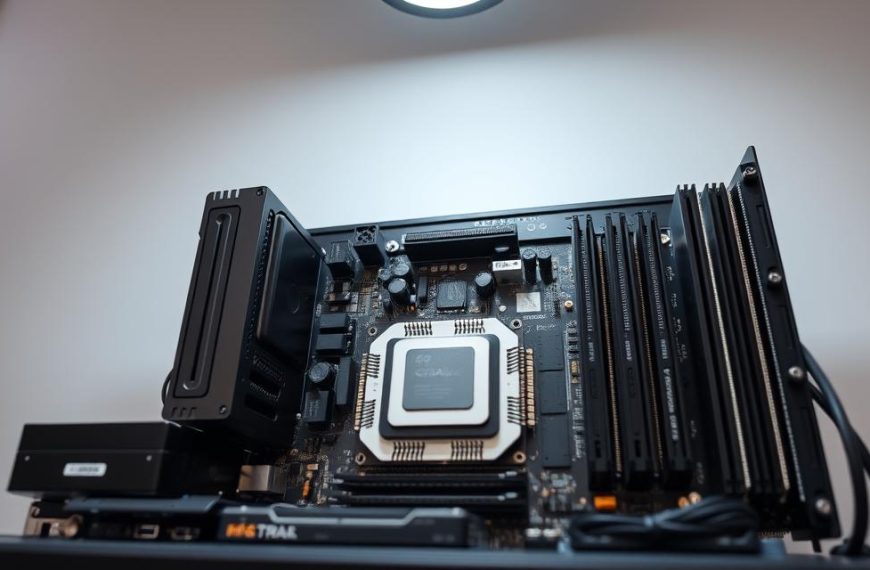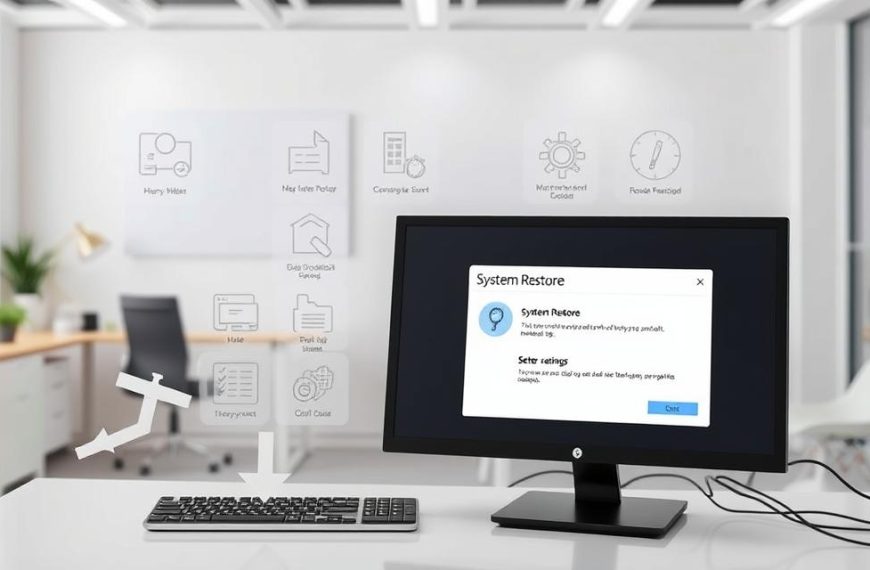Today’s businesses use advanced data management systems to handle their key information. These systems are a big change from old ways like index cards and paper files.
This setup is like a digital library, using special software to manage data. It works with users and apps to get and understand information well.
Thanks to computerised data processing, companies can turn simple data into useful insights. Digital information handling systems are key to doing well in today’s data-rich world.
Fundamentals of Computer-Based Information Systems
Learning about the basics of computer-based information systems is key. It shows how companies manage their digital stuff. These systems are the heart of today’s data work, combining parts to meet business goals.
Essential Components and Architecture
A strong DBMS architecture has six main system components working together. Each part has its own job to make sure data is handled well and the system is reliable.
The hardware part includes servers, storage, and networking gear. These physical bits support the software layer where the database management happens.
Software is the system’s brain, with systems like Oracle and MySQL at its core. These apps handle data definition, updates, and retrieval, which companies use every day.
Data comes in two forms: operational data and metadata. Operational data is the actual business info, while metadata describes the data’s structure and characteristics. Both need careful management.
Procedures set the rules for using the system, keeping it consistent and data safe. These rules help ensure operations are standardised across users and departments.
Database access languages, like SQL, connect users to the data. This standard way of talking to the data makes it easy to manage and get information from.
People are the human side, including admins, developers, and users. Each group uses the system in their own way, needing the right access and training to work well.
The Information Processing Cycle
The information processing cycle is how data moves through a system. It has four main data processing stages that turn raw data into useful insights for the company.
Input is the first stage where data comes into the system. This can be from manual entry, automated feeds, or real-time data capture.
Processing is when the system works on the data. It organises, calculates, and changes the data into formats that are useful for business needs.
Output gives the processed data to users in formats they can use. This could be reports, dashboards, or direct access to query results that help with decision-making.
Storage keeps both raw and processed data safe for later use. Modern systems use advanced storage solutions that balance ease of access, security, and cost while keeping data safe.
This cycle keeps going, with each stage leading into the next. Knowing these basics helps companies improve how they handle data and get the most from their information.
Types of Information Systems for Data Management
Organisations use different systems to manage their data well. Each system has its own role and targets various levels of management. Knowing these systems helps businesses pick the best tools for their needs.
Transaction Processing Systems
TPS systems are key to daily operations. They handle lots of routine tasks with great accuracy. These systems make sure orders, payments, and inventory updates are correct.
They capture data in real-time. This keeps operations running smoothly and cuts down on mistakes. Most businesses count on these systems for their main activities.
Management Information Systems
MIS reporting turns raw data into useful insights. These systems pull together data from different sources. They create reports for middle managers to make tactical decisions.
They produce summary reports and look for exceptions. The focus is on past and current data. This lets managers keep an eye on how the organisation is doing.
Decision Support Systems
DSS analytics give top management advanced tools. These systems tackle semi-structured and unstructured problems. They use models and simulations.
“What-if” analysis is possible with interactive tools. These systems help with long-term planning, not just day-to-day tasks. They let managers explore complex scenarios before making decisions.
Each system type meets different organisational needs. From supporting operations to planning strategies, they form a complete data management structure. Using them right ensures information flows well across all levels.
Design Principles for Effective Data Handling Systems
Building strong data handling systems needs careful attention to key design principles. These principles are essential for making systems reliable and trustworthy. They cover both technical details and safety measures.
Good system design is more than just working well. It also means keeping data quality high and protecting it from threats. Companies should focus on these points from the start to the end.
Data Integrity and Validation Mechanisms
Keeping data accurate requires strong validation strategies at every level. These steps stop errors from getting in and keep data consistent.
Proper data validation rules are the first defence against wrong information. These rules can include:
- Format checks ensuring data follows specific patterns
- Range validation confirming values fall within acceptable limits
- Consistency checks across related data fields
- Uniqueness constraints preventing duplicate entries
Database constraints add another layer of protection. Primary keys make sure each item is unique. Foreign keys keep data in tables related correctly. Normalisation reduces data redundancy and improves consistency.
“Data integrity isn’t an optional feature—it’s the fundamental requirement for any system handling organisational information.”
Checking data in real-time catches errors right away. This saves money later. Automated checks spot problems before they spread, keeping data clean.
Security Framework Design
Keeping sensitive info safe needs a layered security approach. A solid information security architecture fights threats from all sides while keeping access open to those who should have it.
Access control is key to protecting data. Role-based permissions, set with Data Control Language commands like GRANT and REVOKE, let users see only what they need. This limits damage if someone’s account is hacked.
Encryption keeps data safe, whether it’s sitting idle or moving around. Modern systems use top-notch encryption to keep info safe, even if someone gets their hands on it.
A study in Frontiers in Computer Science says today’s security frameworks must keep up with new threats. They need to adapt to stay ahead.
Audit trails are vital for watching over data. They record all access and changes. This helps spot and deal with suspicious activity fast.
Having a plan for disaster recovery is the last piece of the puzzle. Regular backups and tested plans keep data safe from hardware failures or big disasters.
| Security Layer | Protection Mechanism | Implementation Example |
|---|---|---|
| Access Control | Role-based permissions | GRANT SELECT ON customer_data TO sales_team |
| Data Encryption | Advanced Encryption Standard | 256-bit encryption for database files |
| Monitoring | Comprehensive audit trails | Log all data modification attempts |
| Recovery | Automated backup systems | Daily incremental backups with weekly full backups |
Good data protection design brings all these parts together into a system that keeps up with threats. Regular checks and updates keep it strong against new dangers.
Security is not a one-time thing. It’s an ongoing effort. Keeping an eye on things, training, and regular checks keep security strong over time.
A Computer Based Information System Designed to Handle Organisational Data
Setting up an enterprise data system needs careful planning for success. These systems must handle today’s data and grow with the future. They should also fit well with how the organisation works.
Scalability and Performance Considerations
Today’s businesses need systems that can grow with them. Scalability means both hardware and software working together. Companies must decide between adding more to existing servers or adding more servers.
Choosing the right hardware is key for performance. Using multiprocessor servers and RAID arrays helps manage big data. Database servers need to be set up right to keep up during busy times.
Query optimisation is also vital. Good database structure and indexing keep data retrieval fast, even as data increases. Regular checks help spot problems before they cause trouble.
Integration with Business Processes
Good business process integration changes how companies work. Enterprise Resource Planning (ERP) systems link different departments with one data source.
These systems break down information barriers between finance, HR, and supply chain. This gives a clear view of the organisation, helping make better decisions.
Integration success comes from matching system features with business needs. This makes the data system a tool for strategy, not just data storage. It helps improve how the organisation works.
Success in implementation depends on how well the system fits with current processes. The aim is to create a smooth flow of data across all business areas.
Implementation Strategies and Best Practices
Deploying a computer-based information system needs careful planning. It involves both technical and human aspects. Organisations must tackle technological challenges and adapt their workforce to achieve success.
System Selection and Customisation
The key to a successful DBMS implementation is choosing the right platform. Decision-makers should look at scalability, integration, and cost. These factors are essential for your organisational needs.
When evaluating systems, consider:
- Data volume and transaction processing demands
- Compatibility with existing infrastructure
- Vendor reputation and support services
- Future expansion capabilities
Customising software is important to fit it to your business. But, it’s also important to keep it maintainable. Too many changes can make upgrades hard and increase costs over time.
The table below shows important criteria for choosing and customising data management systems:
| Evaluation Criteria | Relational Databases | NoSQL Systems | Cloud-Based Solutions |
|---|---|---|---|
| Data Structure | Structured, tabular | Flexible, document-based | Variable depending on service |
| Scalability Approach | Vertical scaling | Horizontal scaling | Elastic scaling |
| Customisation Level | High through SQL | Schema-less flexibility | Platform-dependent |
| Implementation Complexity | Medium to high | Low to medium | Low (managed service) |
Change Management and User Training
Effective user adoption strategies are key to success. Overcoming resistance to new systems is a challenge. It requires clear communication and involvement.
Creating detailed training programmes is essential. It covers different roles in the organisation. Users need practical training, while administrators and developers require more technical knowledge.
Successful change management includes:
- Early stakeholder engagement and communication
- Phased implementation with pilot testing
- Continuous feedback during transition
- Clear support and help resources
Organisations should track adoption success and identify support needs. Regular checks ensure the system meets expectations and users are confident with new tools. For more information, see our guide on implementing and maintaining information systems.
Training’s impact on system use and data quality is significant. Invest in ongoing education to keep up with changes. This approach ensures the system’s long-term success.
Emerging Trends and Future Developments
Data management is changing fast, thanks to new tech. Cloud computing and artificial intelligence are leading this change. They are making big improvements in how we handle and analyse data.
Cloud-Based Solutions and Their Impact
Cloud platforms have changed how businesses manage data. Services like Amazon RDS and Google Cloud SQL offer strong alternatives to old systems. Moving to cloud data management brings many benefits:
- It makes scaling up or down easier
- It cuts down on management work
- It’s cheaper because you only pay for what you use
- It lets you work from anywhere
But, moving to the cloud means you must think about data privacy laws. You also need to make sure your data is safe. It’s important to know who is responsible for what in the cloud.
Artificial Intelligence and Machine Learning Integration
AI is changing the future of DBMS a lot. Today’s databases are getting smarter. They’re not just for storing data anymore. They help with analysis and making decisions.
AI in database systems brings many cool features:
- It can predict what you need before you ask
- It can fix problems on its own
- It can spot problems in real time
- It can find insights in data automatically
These smart systems can look at huge amounts of data. They find trends and patterns that humans might miss. This helps businesses make better decisions.
As these techs get better, they will work even closer together. The line between databases and analysis tools will keep getting smaller. This will make working with data easier for everyone in business.
Conclusion
A well-designed computer-based information system is key to success today. It turns raw data into useful information. This helps in making informed decisions across all business areas.
Managing information well is vital in our data-driven world. These systems help businesses stay ahead by being efficient and strategic. They keep data safe and work smoothly with business processes.
Investing in good data management is more than just tech. It’s a core business strategy. It helps businesses grow and adapt to new tech like cloud computing and AI.


















